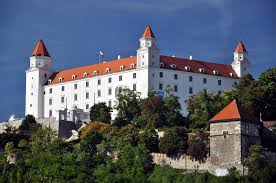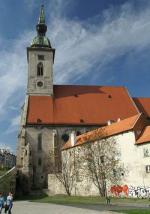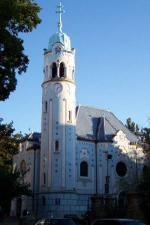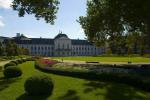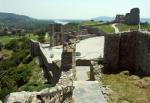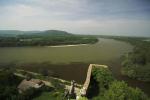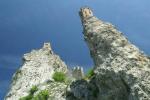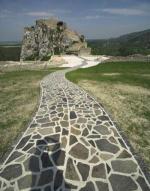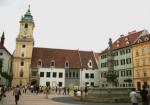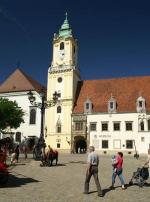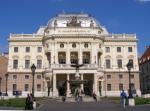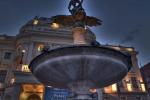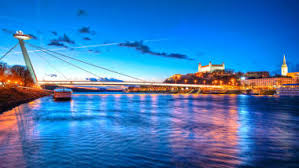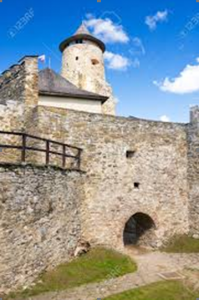What to see in Bratislava? Here we bring you few ideas about Bratislava – coronation city. More ideas in the next article.
Over the course of its history Bratislava was a significant Celtic Centre, an important part of Limes Romanus, a point where Slavic and Germanic tribes clashed, a site of political struggle between Hungarian and Austrian interests, the coronation capital of Hungarian kings for more than 300 years, the favourite summer residence of Empress Maria Theresa; a region famous for its wine making traditions.
Situated on the border of three countries, Slovakia, Austria and Hungary, today Bratislava is a free young and modern capital.
-
Bratislava Castle
Bratislava Castle or Hrad sits on a hill overlooking the city. Initially a Roman frontier post, there has been a castle at this site since the 9th century. In 1881, it was reduced to rubble due to a fire and wasn’t reconstructed until the mid 1900s. Its appearance has been likened to an upside down table with four corner towers that look like table legs. In spite of its drab exterior the Castle is worth a visit for the museums housed inside as well as the panoramic views over the city.
The various rooms of The History Museum and the National Museum are a worth to visit. A large section was devoted to art – approximately 3500 paintings, statues, and prints by domestic and foreign artists grouped according to theme. Religious art in one room, painting and portraits of royalty such as Maria Theresa and Maria Antoinette in another, more portraits and finally, sculpture and modern art such as Julius Koller’s question mark canvas. One of the highlighted displays was copies of 15th century altarpieces and church statues done by Paul of Levoca and many of his students.
Other rooms, large enough to double for warehouses, were filled with coloured Slovakian glassware, carved wooden furniture, clocks, weapons, helmets and armor. There is an impressive display of silver with bowls, plates and utensils from the 17th to 19th century. Also impressive was a Renaissance jewel chest, circa 1600, and a replica of the crown of the Hungarian kings. Near the crown was a steep flight of stairs leading to the Crown Tower, a small enclosed tower offering 360 degree views of the city.
-
St Martin’s Cathedral in Bratislava
Situated on the edge of the Old Town, St. Martin’s Cathedral is Bratislava’s foremost Gothic structure. The church, originally built in the 13th century in the Romanesque style, was replaced by a 3-nave Gothic Dome in the late 14th century. The new St. Martin’s Cathedral was consecrated in 1452 and underwent several lengthy reconstructions in later centuries. In the 16th century, the Dome became the coronation church of Hungarian kings and there were 19 Hungarian Emperors (including Maria Theresia) crowned in the cathedral until the 19th century. The cathedral was actually built into the town’s outer walls as part of its fortification.
The cathedral has three naves, with several chapels added from time to time over the centuries. Its most famous work of art is an 18th century statue of St. Martin and the Beggar sculpted by famous Austrian baroque sculptor Raphael Donner. Another sight not to miss is St. Stephen’s Crown, a 1m high copy of the Hungarian royal crown placed on the church tower, some 85 meters (280 feet) above town. Over the portal that used to be the cathedral’s main entrance, there is a Gothic relief depicting the Holy Trinity.
Facing the rear of the church after walking in, there is a gallery where the king could sit above the congregation during services. On a tablet underneath this gallery on the rear wall of the church is a notice commemoratingBeethoven’s op. 123, which premiered here during the 18th century. The especially vivid stained glass in St Martin’s draws the viewer forward into the main body of the church, where thick columns support the church roof.
The surroundings of St Martins are as memorable as the structure itself. In the cathedral’s case, this includes the picturesque remains of outbuildings in a spacious staired courtyard, and a working seminary with robed adepts on a cobblestone side street. A small but significant neighbour of the cathedral is a monument to the synagogue, which stood next door for centuries until the communist government demolished it around 1970 to make room for the new bridge.
-
St. Elizabeth’s Church – The Blue Little Church in Bratislava
St. Elizabeth´s Church, commonly known as the Blue Church is of the few examples of art nouveau architecture in Bratislava. It was built between 1909-13 according to plans of Hungarian architect Edmund Lechner and was initialy intended to be a chapel for students from the neraby school. It is dedicated to St. Elizabeth of Hungary. Its familiar name was drawn from the color that dominates both its interrior and facade.
-
Grassalkovich Palace – Slovakia’s White House
Now the home of the president of Slovakia, Grassalkovich Palace was once the home and meeting place for several members of the Austro-Hungarian and Habsburg aristocracy.
Grassalkovich Palace was built in the 1760’s by Count Anton Grassalkovich, the President of the Royal Hungarian Chamber and advisor to the Empress Maria Theresia. It is said that the inventor Wolfgang von Kempelen introduced several of his inventions, including a speaking machine, in the palace’s State Rooms.
Grassalkovich Palace is guarded 24 hours a day by an honour guard that can be seen marching in front of the castle daily by visitors. Grassalkovich Palace is situated in a huge, open park with a Baroque garden that is open to the public, even when the President is in residence.
-
Devin Castle
Devin Castle above the confluence of the rivers Danube and Morava is one of the three oldest historically acknowledged castles in Slovakia. The village of Devin is now a part of Bratislava. Oldest traces of settlement there date back to the 5th century B.C. Due to its advantageous geographical position, it was able to control the most important trade routes along the Danube as well as one part of the Amber Road. In the 1st century B.C, the territory was populated by Celts. The castle played an important role as a boundary fortress as a part of the Limes Romanus fortifications against enemies at the times of the Roman Empire and as a military station and trade centre at the times of the Great Moravian Empire the first Slavic state. The first written reference to the castle and its ancient name – Dowina comes from 864. After the fall of the Great Moravian Empire, the castle served again as a boundary fortress under the reign of the Hungarians. The castle was altered in 13th and 16th century and destroyed by Napoleon’s troops in 1809.
Devin Castle has been a National cultural monument since 1961. Nowadays the castle serves as a museum. The middle-castle is used as a show-room for seasonal exhibitions concerning history of the castle which artefacts date back to the ancient times and Middle Ages. The caves are used as a show-room for permanent exhibition under the name “Architectural development of Devin Castle”. The displayed artefacts date back to 12th – 19th century.
The castle is open to the public May-October daily except for Mondays from 10am to 5pm and on weekends from 10am to 6pm. The castle is accessible by car (direction Karlova Ves and Devin), public transport (bus No. 29 from bus stop under the New Bridge – Novy most ), boat, bicycle or walking. The boat leaves twice a day from a special port near the city centre (Fajnorovo nabrezie 2 – Fajnorovo Embankment). From April 25 to May 21 and from August 29 to September 17 the boat leaves the port in Bratislava at 11am and 4pm. From May 23 to August 27 the boat leaves the port at 10 am and 2:30 pm. It is possible to carry a bicycle.
-
Old Town Hall in Bratislava
Originally the site of a towered house in the 14th century, the old town hall arose in the 15th century by connecting several burgher houses, and then went through several reconstructions in the course of the centuries. After the earthquake of 1599, it was reconstructed in Renaissance style, while the town-hall tower was rebuilt in baroque style in the 18th century. In 1912 the rear wing was constructed in neo-renaissance style from the side of the courtyard, and neo-gothic style from the side of the Primacial square.
The town-hall tower was of defensive nature. At the bottom, you can find a table with the date of February 1850, marking the high water level when the Danube flooded. Left of the Gothic window, there is immured a cannon ball commemorating the attacks of Napolenonic troops in 1809. At the corner of the tower, the statue of Madonna of 1676 is located. Decisions of the assembly, royal decrees and orders of the town council were announced from the balcony of the tower in the past. Note a fresco of an old man of 1533 as well as a statuette of the Hungarian King – St. Ladislaus.
The Municipal museum is the oldest museum in Bratislava, as it was founded in 1868. Entrance to the exhibition of the feudal justice system and history of the town is in the corner of the courtyard.
-
The Slovak National Theatre – Opera & Ballet House
The Neo-Renaissance Slovak National Theatre, standing at the end of the long Hviezdoslav Square (Hviezdoslavovo námestie), was built in 1885-1886 during the time of Austria-Hungary, based on a design by the Viennese architects R. Fellner and H. Helmer, who designed theatre buildings in 10 European countries. It was opened as the City Theatre on September 22, 1886 with the opera Bánk Bán of F. Erkel.
We are glad to provide you our services.
 +421 948 365 187
+421 948 365 187 info@realdealplus.com
info@realdealplus.com